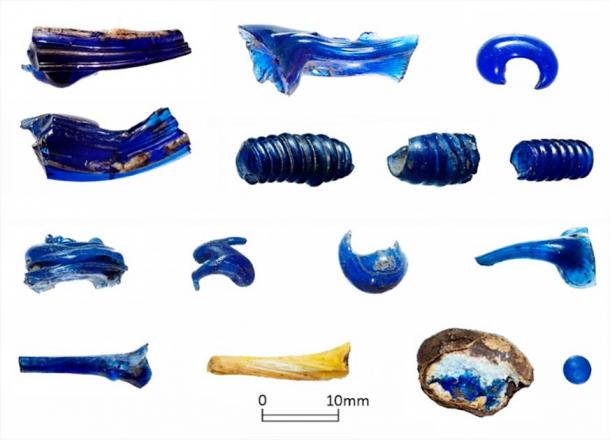
2300-year-old Glass Workshop and Ritual Sanctuary Uncovered in Czech Republic!
Němčice in the Czech Republic was a seemingly inconspicuous place with a remarkable history. Now it holds the proud distinction of being the earliest and oldest glass workshop north of the Alps! Archaeologists found it to be a vital center of glass production 2,300 years ago. But that was not all. This Transalpine Iron Age site was also realized to be an important center of trade, due to the healthy presence of 2,000 gold and silver coins!
A Workshop Par Excellence
The workshop, dating back to the Iron Age, played a pivotal role in producing exquisite glass bracelets and beads. This trading relationship involved the Celts, who inhabited continental Europe at the time. In addition, it also housed a possible ‘sanctuary’ which has pointed to shared ritual practices with other Central European sites. All of these finds have been revealed in a brilliant new study published in the most recent edition of the journal Antiquity.
“No one yet knows how exactly the Celts made glass bracelets,” said author of the research, Dr Ivan Čižmář from the Institute of Archaeological Heritage Brno, “Therefore, we were interested in anything that tells us something about the technology of production.”
- Eight Surprising Things You Should Know About the Celts
- Even Low-Class Iron Age Celts Sipped Fine Mediterranean Wine

Aerial photograph of the excavation in 2021, with sunken hut (photograph by I. Čižmář/Antiquity Publications Ltd)
Rich Pickings of Němčice
Němčice first came into the spotlight in 2002 during initial excavations, and has been the subject of intense surveys for over 20 years now. Němčice holds a place of significance as one of the most important settlement sites from the La Tène Period (a significant historical and cultural period in European prehistory), spanning the 3rd to 2nd century BC, in central Europe.
The presence of sunken huts, bronze amulets, and scattered coins throughout the site alluded to Němčice's role in the renowned "Amber Road." This vast network interconnected central Europe from the Baltic coast to the Mediterranean region, facilitating trade and cultural exchange, reports Live Science.
The most striking aspect of the discovery is the glass artifacts themselves. Although no glassmaking tools were uncovered, a range of finished and incomplete glass and amber items indicated that the workshop possibly produced these goods onsite rather than relying on imports from distant places.
- How the Great La Tene Culture Changed Iron Age Europe
- The Killing of Swords: A Destructive Funerary Rite To Release the Spirit of Weapons

Evidence of glass production and secondary processing from Němčice (compiled by I. Čižmář/ I. Čižmář/Antiquity Publications Ltd).
A Sanctuary for Ritualistic Practices?
In addition to the glass workshop, the archaeological team stumbled upon a square structure with characteristics reminiscent of ancient buildings known to have been used for rituals. One such site is Sandberg in Austria, which was once occupied by Celts. This finding suggests that Iron Age people used Němčice as a possible sanctuary, engaging in various ritualistic practices!
“Another objective of the planned exploratory excavation is not only the clarification of the standing of the site in the broader Central European territory, but also of its functioning and of life at the settlement in connection with the socio-cultic sphere—a very important aspect of the life of every society,” they write in the study.
The implications of this discovery are far-reaching, offering a glimpse into the intricate web of trade and cultural connections that existed in ancient times. These finds underscore the exceptional craftsmanship of the Iron Age artisans who skillfully produced the delicate glass and amber items, finished exquisitely.
According to Dr Čižmář, “The presence of these likely sacred features at Němčice indicates the character of the site not only as a trade and production center, but also as a seat of an elite and a ritual center.”
The La Tène Culture and Period: When the Celts Met the Greeks
The La Tène period encompasses the material culture of the latter phase of the Iron Age, spanning across a large part of northern and western Europe from approximately 450 BC to the time of Roman conquest (1st century BC).
The term "La Tène" originates from an archaeological site, situated on the shores of Lake Neuchâtel in Switzerland, where the earliest artifacts of this distinctive culture were unearthed during the late 19th century.
The culture originates when the Indo-European peoples (the Celts) came in contact with Greek and Etruscan influences from the south of the Alps. Over the course of the next four centuries, the La Tène culture underwent several phases and regional variations as the Celts extended their influence across a vast expanse, encompassing most of northern Europe and the British Isles.
The Celts of the La Tène culture were active traders and engaged in extensive commercial networks across Europe. They established connections with neighboring regions and beyond, participating in long-distance trade routes, such as the aforementioned "Amber Road," which facilitated the exchange of goods and ideas. Though its decline was rapid after coming into contact with the Romans, it remains one of the most important pre-Roman cultures of Europe.
Top image: Glass artifacts are evidence of Iron Age glass production from Němčice, Czech Republic. Source: I. Čižmář/Antiquity Publications Ltd
By Sahir Pandey
References
Němčice: research at a key La Tène site in Moravia. Antiquity, 97 (394). Available at: https://doi.org/10.15184/aqy.2023.80.
Nalewicki, J. 2023. 2,300-year-old glass workshop littered with Celtic coins is oldest known north of the Alps. Available at: https://www.livescience.com/archaeology/2300-year-old-glass-workshop-littered-with-celtic-coins-is-oldest-known-north-of-the-alps.















